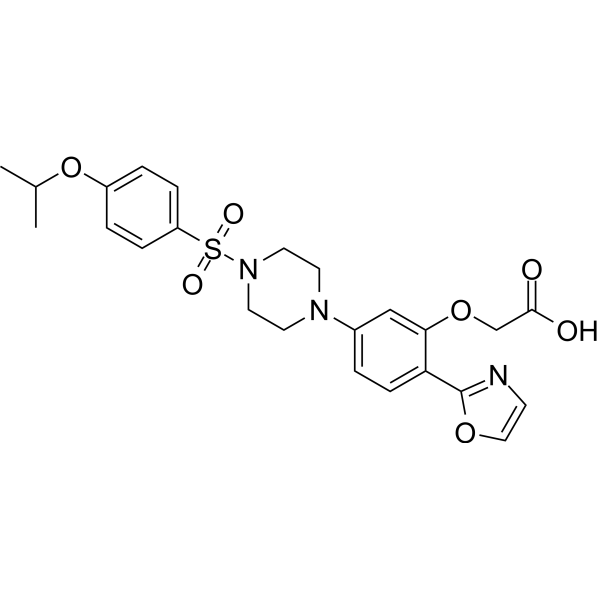Asapiprant S-555739,99.58%
产品编号:Bellancom-16763| CAS NO:932372-01-5| 分子式:C24H27N3O7S| 分子量:501.55
本网站销售的所有产品仅用于工业应用或者科学研究等非医疗目的,不可用于人类或动物的临床诊断或者治疗,非药用,非食用,
Asapiprant S-555739
| 产品介绍 | Asapiprant 是一个强效且有选择性的 DP1 受体拮抗剂,其 Ki 值为 0.44 nM。 | ||||||||||||||||
|---|---|---|---|---|---|---|---|---|---|---|---|---|---|---|---|---|---|
| 生物活性 | Asapiprant is a potent and selective DP1 receptor antagonist with a Ki of 0.44 nM. | ||||||||||||||||
| 体外研究 | |||||||||||||||||
| 体内研究 |
Oral administration of Asapiprant to sheep at 1 and 3 mg/kg significantly (P<0.01) suppresses the increase in nasal resistance by 82% and 92%, respectively. Oral administration of Asapiprant to sheep at 5 mg/kg suppresses Prostaglandin (PG) D2 (PGD)2-induced nasal resistance by 86%. When orally administered 1 h before the antigen challenge in pigs, Asapiprant (3, 10, and 30 mg/kg) suppresses immediate airway response (IAR) by 52%, 57%, and 96%, and late airway response (LAR) by 67%, 50%, and 79%, respectively. Orally administered with Asapiprant (5 mg/kg) for 4 days, the Asapiprant significantly (P<0.01) suppresses antigen-induced nasal resistance by 73% in sheep. Treatment with 3 and 30 mg/kg of Asapiprant in pigs significantly (P<0.01) suppresses nasal secretion by 53% and 72%, respectively. Treatment with Asapiprant in rats at 10 mg/kg significantly (P<0.05) reduces airway hyper-responsiveness (AHR), infiltration of inflammatory cells, and mucin production in bronchoalveolar lavage fluid (BALF), although treatment with Asapiprant at 0.1 mg/kg does not have a significant effect on any responses. 西域 has not independently confirmed the accuracy of these methods. They are for reference only. | ||||||||||||||||
| 体内研究 |
Oral administration of Asapiprant to sheep at 1 and 3 mg/kg significantly (P<0.01) suppresses the increase in nasal resistance by 82% and 92%, respectively. Oral administration of Asapiprant to sheep at 5 mg/kg suppresses Prostaglandin (PG) D2 (PGD)2-induced nasal resistance by 86%. When orally administered 1 h before the antigen challenge in pigs, Asapiprant (3, 10, and 30 mg/kg) suppresses immediate airway response (IAR) by 52%, 57%, and 96%, and late airway response (LAR) by 67%, 50%, and 79%, respectively. Orally administered with Asapiprant (5 mg/kg) for 4 days, the Asapiprant significantly (P<0.01) suppresses antigen-induced nasal resistance by 73% in sheep. Treatment with 3 and 30 mg/kg of Asapiprant in pigs significantly (P<0.01) suppresses nasal secretion by 53% and 72%, respectively. Treatment with Asapiprant in rats at 10 mg/kg significantly (P<0.05) reduces airway hyper-responsiveness (AHR), infiltration of inflammatory cells, and mucin production in bronchoalveolar lavage fluid (BALF), although treatment with Asapiprant at 0.1 mg/kg does not have a significant effect on any responses. 西域 has not independently confirmed the accuracy of these methods. They are for reference only. | ||||||||||||||||
| 性状 | Solid | ||||||||||||||||
| 溶解性数据 |
In Vitro:
DMSO : 11.11 mg/mL (22.15 mM; Need ultrasonic) 配制储备液
*
请根据产品在不同溶剂中的溶解度选择合适的溶剂配制储备液;一旦配成溶液,请分装保存,避免反复冻融造成的产品失效。 In Vivo:
请根据您的实验动物和给药方式选择适当的溶解方案。以下溶解方案都请先按照 In Vitro 方式配制澄清的储备液,再依次添加助溶剂:
——为保证实验结果的可靠性,澄清的储备液可以根据储存条件,适当保存;体内实验的工作液,建议您现用现配,当天使用;
以下溶剂前显示的百
| ||||||||||||||||
| 运输条件 | Room temperature in continental US; may vary elsewhere. | ||||||||||||||||
| 储存方式 |
| ||||||||||||||||
| 参考文献 |








 浙公网安备 33010802013016号
浙公网安备 33010802013016号